Technical Journal
The Technical Journal is ULVAC Group's technical information magazine. The latest issue can be downloaded from this site. Once you have entered and submitted your customer information, you can download the Technical Journal.
If you would like to download the file, please fill out this form.
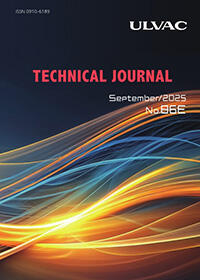
No.86E
September|2025
-
Development of Li Metal Anode with Modified Layer for All-Solid-State Batteries using Vacuum Deposition ProcessDOWNLOADTakahito KIMOTO, et al.
All-solid-state batteries (ASSB) are composed entirely of solid materials and have an extremely low risk of ignition and better safety than conventional lithium-ion batteries.
In addition, all-solid-state lithium metal batteries, which use lithium metal as the anode material, are attracting attention as batteries that can achieve an energy density that surpasses that of conventional lithium-ion batteries.
In this study, a Li metal anode made by a vacuum deposition process to have a modified layer for a sulfide-based all-solidstate electrolyte was evaluated. Mg was selected for the modified layer, and the results show that a great ASSB performance was successfully achieved. -
Basic Research for Acquiring Advanced Pathological Information by Circularly Polarized Light Analysis of Biological TissueDOWNLOADShintaro TODA, et al.
Non-invasive diagnosis using circularly polarized light (CPL) is a promising next-generation medical technology. In this study, the visible CPL characteristics of human lung adenocarcinoma were evaluated. Cultured cell samples (normal and cancerous) and sliced tissue samples (non-metastatic and metastatic cases) were irradiated with white CPL, and the polarization state of the transmitted light was analyzed by the polarizer rotation method. As a result, the depolarization ratio and its circular dichrosim (CD) were larger in the cancerous cells (or tumor region) than in the normal ones in all samples. In addition, there was a gap between the different CDs of the normal and the tumor region in each non-metastatic and metastatic sliced tissue sample.
These findings suggest that polarization parameters may be applicable to distinguishing between normal and cancerous cells (or tumor regions) and to evaluating the malignancy of a cancer. -
Development of Skyrmion Brownian DevicesDOWNLOADRyo ISHIKAWA, et al.
Magnetic skyrmions are vortex-like spin textures that are stabilized due to topological protection and exhibit Brownian motion in solids. Owing to the high applicability of skyrmions in Brownian motion as an information carrier, applications in unconventional computing such as probabilistic and Brownian computing are expected. Some work on how to control the Brownian motion of skyrmions is introduced in this manuscript.
-
Dielectric Material Etching Module for Electronic Device Manufacturing LinesDOWNLOADToshiyuki NAKAMURA, et al.
We have developed a dielectric material etching module capable of processing wafers up to eight inches in diameter for electronic device manufacturing lines. This module is a narrow-gap, capacitively coupled plasma etching system powered by a 400 kHz high-frequency power supply, specifically designed for etching dielectric materials using fluorocarbon-based process gases. It offers excellent etching uniformity, reduced metal contamination, and lower particle generation, achieved through optimized components such as single-crystal silicon parts, ceramic electrostatic chucks, and an isotropic exhaust structure.
-
Applications Using Fully Automated, Multi-Technique Scanning XPS Equipment Pioneered by Innovative TechnologyDOWNLOADMaki HASHIMOTO, et al.
With the advancements in high-performance materials in recent years, devices combining these materials have become increasingly complex in structure. In particular, the analysis of material interfaces, which play a critical role in device functionality, has gained significant importance. X-ray photoelectron spectroscopy (XPS) has become indispensable as a surface analysis technique. XPS enables precise measurement of the chemical states and elemental concentrations of material surfaces and is widely utilized in the development of battery and semiconductor materials. This article introduces the features and applications of the fully automated, multifunctional XPS system PHI GENESIS.
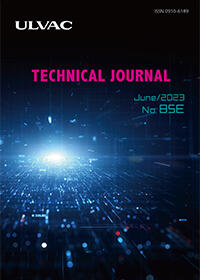
No.85E
June|2023
-
New Inductively Coupled Plasma Source for uGmni Etching Module - "ISM-duo"DOWNLOADKenta DOI, et al., ULVAC, Inc.
Our new plasma source "ISM-duo" enables the across-wafer etching rate uniformity of our uGmni etching module to be controlled. ISM-duo consists of an RF current distribution unit and two separate ICP antennas placed coaxially so as to control the spatial distribution of plasma generated in the process chamber. The RF current distribution to each antenna is performed at an arbitrary ratio without depending on process parameters such as gas type, and changing the distribution ratio does not disturb impedance matching. These features enable a stable operation of the etching rate uniformity control through the optimization of the RF current distribution ratio for various processes. ISM-duo delivers a new process tuning knob that enlarges the process window in our etching module.
-
Development of Sputtering Module "SEGul" for Forming GaN Epitaxial Thin FilmsDOWNLOADMasanori SHIRAI, et al., ULVAC, Inc.
We have developed the radical assist sputter epitaxy (RaSE) method to enable epitaxial growth of gallium nitride (GaN) by sputtering and the "SEGul" system for mass production. Compared to the metal organic chemical vapor deposition (MO-CVD) method, which is a common GaN film formation method, the RaSE method has the advantages of a low deposition temperature and a low material cost when forming epitaxial GaN thin films. The MO-CVD method uses organometallics and toxic gases such as NH₃ as raw materials at a formation temperature of about 1000℃. In contrast, the "RaSE" method uses common materials such as Ga, N₂, and Ar, and GaN formation can be performed at relatively low temperatures of 700℃ or lower. It can also be applied to the formation of high density n-type GaN thin films with n-type carrier density in the 1x1020 cm-3 range by using an additional sputtering source for doping. In this report, we describe the characteristics of GaN thin films formed by the RaSE method, as well as the mass production system "SEGul" which can handle up to 8-inch wafer sizes.
-
Development of Low Damage Sputtering Process for OLED DevicesDOWNLOADJunsuke MATSUZAKI, et al., ULVAC, Inc.
Organic light emitting diode (OLED) devices are applied to various displays such as smartphones, monitors, and TVs, but it is necessary to improve the cost and lifetime of such displays. Top emission type OLEDs have high light extraction efficiency but require higher transmission and lower resistance cathode electrodes, so we have developed a low damage sputtering process for these OLED devices.
Sputtering processes with high temperatures and lots of particles not only reduce device performance, but also reduce mass production yields. That is why ULVAC's sputtering process concepts for these OLED devices are "low damage," "low temperature," and "low particle."
In this paper, we analyzed the sputtering damage factor related to device performance and established a sputtering process that can reduce the damage factor. The drive voltage and efficiency of OLED devices using the low damage sputtering process was the same as that of the reference vapor deposition device, and the lifetime was more than 20% longer. -
Development of Surface Treatment VACAL®-Z for Vacuum Equipment Using Corrosive GasesDOWNLOADFumiaki ISHIGURE, et al., ULVAC, Inc.
We have developed a method of micro arc oxidation treatment (VACAL®-Z) as a surface treatment for aluminum alloy used in vacuum equipment using corrosive gases, such as CVD equipment. The oxide layer formed by VACAL®-Z had a three layer structure of crystalline γ-alumina. In addition, we have devised and made possible a step processing method for treating the entire surface of large objects, such as vacuum production equipment for flat panel displays, by VACAL®-Z.
-
Development of Batch Type Isotropic Gas SiO₂ Etching System Using HF GasDOWNLOADAtsuaki HASHIMOTO, et al., ULVAC, Inc.
We have developed a new batch-type isotropic gas etching system that does not utilize H radicals. The isotropic gas etching process is used in semiconductor manufacturing to etch pattern structures and requires high aspect ratio etching without causing damage to the underlying layer. Our previous release, RISE-300, was a batch-type gas etching tool that utilized H radicals and was easy to handle due to the absence of highly corrosive gases like HF. However, it was difficult to control the etching distribution within each batch. In recent years, conventional processes have become insufficient to meet the performance requirements of device manufacturers. Our new batch-type isotropic gas etching process, which does not utilize H radicals, outperforms conventional methods in terms of wafer-to-wafer uniformity and step coverage. Additionally, this new process allows for precise control of etching distribution within the wafer plane.
-
22-inch Cryopump that Achieves Both Cost Reduction and Energy SavingDOWNLOADYoshinobu MURAYAMA, et al., ULVAC CRYOGENICS, Inc.
The size of glass substrates in organic light emitting diode (OLED) vapor deposition equipment has increased, the mainstream has changed from conventional G6H devices to G8H devices, and the vapor deposition equipment itself has also become larger. Therefore, cryopumps used as high vacuums pumps will also be increased in size from 20 inches to 22 inches, and pumping speed will increase. In this paper, we introduce the history of 22-inch cryopump development and a technology that realizes both cost reduction and energy saving in a cryopump system that will be adopted in the G8H in the future.
-
ULVAC's Efforts to Ensure Cleanliness of Organic Electro Luminescence Manufacturing EquipmentDOWNLOADJun WATANABE, et al., ULVAC, Inc.
The problem with organic light-emitting diode (OLED) displays is that their service lifetime is affected by impurities in vacuum equipment. Therefore, equipment manufacturers need to ensure the cleanliness of their equipment. We developed a technology to evaluate trace amounts of water-soluble impurities in vacuum equipment by using ion chromatography (IC). As a result, we established our own simple cleanliness evaluation technology.
By using this evaluation technology to monitor and take countermeasures against residual ions in the equipment during each process from manufacturing to delivery, we have been able to manufacture equipment with high cleanliness that meets the required quality.
In addition, we conducted device fabrication and service lifetime tests on OLED deposition equipment to evaluate the impact of equipment components on device lifetime. The evaluation of devices exposed to fluorinated resin-coated cables suggested that the factor causing service lifetime degradation was a gas containing C-F. Meanwhile, it was found that the devices can still be used as device components by reducing the amount of impurities through appropriate cleaning processes. We will contribute to further quality improvement of OLED production equipment by utilizing this technology. -
Filling Technology of Insulating Layers by Phase Position ControlDOWNLOADToshihiko NAKAHATA, et al., ULVAC, Inc.
When radio frequency (RF) power sources are used on both the cathode and stage sides, effective stage bias can be achieved by controlling the RF phase. We found that this can be ascertained from the voltage peak to peak (Vpp) curve at each phase position.
The number of layers in 3D-NAND flash memory is increasing, so the processed height of each layer must be reduced to maintain the total device height. The height of etch-stop layers must also be reduced, and a filling process is required for insulator materials. ULVAC had knowledge of stable RF sputtering processes, but we were not able to produce an adequate filling performance. We knew that the stage bias process used in conventional ULVAC technologies, such as high coverage ionized sputtering (HiCIS), was a good candidate for this filling process. However, it is only used for metal layers, which have lower ionized energy materials. We tried to combine both cathode and stage RF processes, but the filling performance was not stable and we could not control the RF processes together. In order to solve these issues, we found that phase control is one of the key factors to not only use matching control but also control stage bias effectiveness. Also, filling performance can be controlled by selecting the correct phase position for both the cathode and stage RF output. It makes further possibility for sputter process applications.
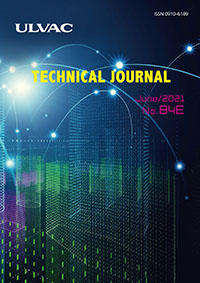
No.84E
June/2021
-
Deposition Technology for Cu Interconnect of Semiconductor DevicesDOWNLOADSatoru TAKASAWA, Kazuhiro SONODA, Kazuhiko TONARI, Masaki UEMATSU, and Yutaka KOKAZE
We have developed pre-treatment, Cu sputtering, and CVD-Co technologies for semiconductor Cu interconnect technology. A new remote plasma process in the pre-treatment technology suppressed damage to low-k films, and uniformity in the wafer surface and stability of continuous treatment were obtained. The new CVD-Co process enabled uniform film formation at a film thickness of 1.5 nm and resulted in good step coverage performance in a fine pattern. In the future, we expect that these interconnect formation technologies will be applied in logic and memory devices.
-
Development of Deposition Technologies and Processes for Phase Change MemoryDOWNLOADTakeshi MASUDA and Takehito JIMBO
Phase change random access memory (PCRAM) is a type of non-volatile memory that is embedded in semiconductor devices and has been put to practical use as storage class memory (SCM) with high speed and large capacity at a lower cost than DRAM. It is also expected to be applied to neural computing, which mimics the neural circuits of the human brain.
In order to realize PCRAM, it is essential to develop film deposition technologies and processes to realize appropriate film properties and mass productivity for memory elements, selector elements, and electrode materials (carbon is widely used). In this paper, we will explain the status of technology development for depositing each of these elements, and also present the evaluation results of a prototype AI device using CVD technology for applications in neural computing. -
Development of Sputtering System ULDiS-1500PHL for Optical Film DepositionDOWNLOADTakuma ARAYA, Tetsushi FUJINAGA, Motoshi KOBAYASHI, Yoshitaka GOUSHI, Harunori IWAI, Hungchun PENG, Szuhsun CHENG, Huang-Choung CHANG
Optical films can select transmittance and reflectance at certain wavelengths by a combination of thin films with different refractive indices. Such films have long been used as anti-reflection (AR) films, specific wavelength transmission filters, and so on. In the past, optical films were deposited on certain substrates and assembled with electronic devices. However, with the miniaturization of electronic devices, it has recently become more common to assemble optical films on wafers and electronic devices before dicing. As a result, a deposition system for optical films is required to allow wafer processing and particle control at the semiconductor level. We developed a sputtering system, ULDiS-1500PHL, for wafers, and present a system and process especially for infrared band pass filters.
-
Development of High Mobility Oxide Semiconductors for Next-Generation Electronic DevicesDOWNLOADTaku HANNA, Mitsuru UENO and Motoshi KOBAYASHI
Transparent amorphous oxide semiconductors (TAOS) typified by amorphous IGZO (In-Ga-Zn-O) are promising materials for next-generation electronic devices. They can provide homogeneous and large area thin films inexpensively by using sputtering equipment for mass production. The special properties of TAOS-based devices, such as their amorphous structure, high mobility and low leak current, may have the potential to replace conventional Si-based technology. Development of new TAOS materials which have high mobility and high reliability is essential for oxide-based technology to become widespread. In this paper we describe Target H, which we developed as a high mobility oxide semiconductor sputtering target. A thin film deposited by DC (direct current) magnetron sputtering shows high Hall mobility above 25 cm2/Vs and an amorphous structure regardless of the partial pressure of oxygen during film deposition. BCE-type TFTs (thin film transistor) using Target H and IGZO were demonstrated. The estimated mobility of Target H was 34.8 cm2/Vs, which is 3 times greater than that of IGZO.
-
Low-damage Dry Etching Technologies for GaN Power DevicesDOWNLOADShinji YAMADA and Toshiyuki NAKAMURA
Presented in this report are low-damage dry etching technologies for Gallium nitride (GaN) power devices using inductively coupled plasma reactive ion etching (ICP-RIE) equipment with a newly-developed high-frequency RF power supply. GaN vertical trench-gate metal-oxide-semiconductor field-effect transistors (MOSFETs) are promising devices for realizing high-breakdown voltage and low on-resistance. However, generally, when a trench-gate structure is fabricated by ICP-RIE, these properties degrade due to plasma-induced damage which is formed near the GaN surface. Our RF power supply contributes to the reduction of this damage by outputting accurately-controlled and ultimately-low bias power. This report introduces an overview of the RF power supply and recent achievements using the same
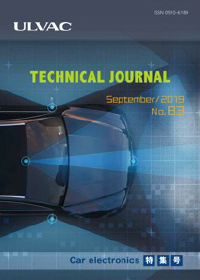 Car Electronics
Car Electronics
No.83E
January/2020
-
Manufacturing Technology for Functional Material Films for Automotive MEMS SensorsDOWNLOADTakehito JIMBO, et al., Institute of Semiconductor & Electronics Technologies
We describe in this article MEMS sensors for automotive applications and related functional material films, a deposition technology for which we have developed. The performance of automobiles is enhanced by their control systems, leading to reduced fuel consumption, higher safety, and other advantages. A MEMS sensor is an essential component of a control system because it can detect environmental changes and feed this information back to the system. The importance of automotive MEMS sensors is increasing due to the design requirements for nextgeneration automobiles, such as self-driving and all-electric vehicles. It is anticipated that by applying a variety of functional materials, a MEMS sensor with new functions will be realized. More specifically, this article introduces the PZT and VOx functional material films that have been developed by the authors. Both films are deposited by the sputtering method, demonstrating that films characterized by excellent performance can be obtained by applying a unique sputtering and process technology.
-
Dry Etching Technologies for 3D Sensors for AutomobilesDOWNLOADKanji FURUTA et al., Advanced Electronics Equipment Division
3D sensing devices for autonomous vehicles have seen major technical advances in recent years. Light Detection and Ranging (LiDAR) has emerged as the technology most compatible with these sensors, as it possesses characteristics that promise to enhance the functionality of autonomous driving. Vertical Cavity Surface Emitting Lasers (VCSELs) are economical and compact enough to serve as light sources for LiDAR. Dry process is the key to VCSEL fabrication. However, this fabrication method poses various challenges. To produce these devices, we have been developing a high-uniformity etching technology, along with an Interferometry End Point monitoring system. This article elaborates on the solutions we implemented to address these challenges.
-
Development of an Li Metal Anode Using a Vacuum Evaporation ProcessDOWNLOADAkihiro YOKOYAMA, et al., Institute for Super Materials
Because the market for lithium ion batteries is expected to grow rapidly, efforts are underway to develop an advanced rechargeable Li-ion battery. One approach for such a rechargeable battery that is attracting attention uses lithium metal as the anode, because the result would be a high-capacity, lightweight battery that is ideal in terms of energy density. However, in order to put a lithium metal anode into practical use, it is necessary to solve the problem of dendrites that occur during repeated cycles of charging and discharging. Other issues that need to be addressed include safety and battery life. Compared to conventional roll-press Li foil, our vacuum evaporated Li film has shown excellent cycle performance. We were also able to stabilize the active Li surface after deposition by applying a "chemical-passivation" process that we developed.
-
Vertically Aligned Carbon Nanotube Electrode and Application to a Lithium Ion CapacitorDOWNLOADYoshiaki FUKUDA, et al., Institute for Super Materials
Carbon nanotube (CNT) electrodes vertically aligned on a copper foil substrate have been fabricated by using a thermal chemical vapor deposition (CVD) method. In the electrode, superior electron conduction paths are formed over the entire electrode. The electron conduction paths are due to the fact that the CNTs are vertically aligned on the substrate with strong adhesion. Such a vertically aligned CNT electrode has been applied to a lithium-ion capacitor (LIC) as a negative electrode material. The fabricated LIC shows high energy density compared to an electric double-layer capacitor (EDLC) to which a commercially available activated carbon electrode material has been applied. This fabricated LIC also demonstrates high power density compared to an LIC to which a commercially available graphite anode has been applied.
-
Power Devices Used in Automobile TechnologyDOWNLOADAkihiko KOHRA, et al., Institute of Semiconductor & Electronics Technologies
Dramatic changes have been occurring in the automotive industry. Among the targets of technological development has been the shift to all-electric vehicle (EVs) and fuel-cell vehicles (FCVs). Batteries, motors, and power devices represent the most essential technologies for EVs and FCVs. A power device is a semiconductor element that functions as a switch for converting the electric power. Examples include metal oxide semiconductor field effect transistors (MOSFETs) and insulated gate bipolar transistors (IGBTs). Power device technology is currently based primarily on silicon (Si) wafers. Silicon carbide (SiC) and gallium nitride (GaN) are gaining attention as next-generation alternatives due to their high voltage resistant property with low electric resistance, which is well suited to power devices. ULVAC is working on productivity enhancement for thin Si wafer processing equipment, ion implantation equipment for SiC, and process development of activating annealing to form a p-type region in GaN power devices based on magnesium (Mg) ion implantation.
-
Industrial Furnaces for Magnets for Vehicle MotorsDOWNLOADShogo MOTEKI, Industrial Equipment Division
Magnets are produced by means of many processes, such as the alloy production process, hydrogen embrittlement process, sintering process, and grain boundary diffusion process. To produce the highperformance magnets required for use in vehicle motors, ULVAC provides an appropriate furnace for each process. The "Magcaster‑600" is a melting furnace for the alloy production process for producing magnets with good grinding characteristics. The "FHH series" includes hydrogen furnaces for the hydrogen embrittlement process without exposure to the air. The "FSC series" provides inline-type heat treatment furnaces for the sintering and aging processes. The "Magrise series" features heat treatment furnaces for the grain boundary diffusion process used to defuse heavy rare metals into neodymium. This article introduces the features of the line of furnaces manufactured by ULVAC for the production of magnets for installation in vehicle motors.
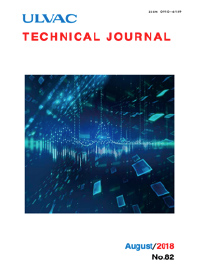
No.82E
January/2019
-
Development of a Wet Rinse Unit-Equipped Dry Etcher for Metal ProcessesDOWNLOADKenji KOMURO, et al., Advanced Electronics Equipment Division
With our dry etching equipment, high density plasma (5E10-1E11/cm3) can be generated at low pressure (0.07-13.3 Pa) by ISM (Inductive Super Magnetron) type plasma source, making it possible to achieve a uniform etching distribution using a magnet. In this issue, we developed dry and wet composite mass production type dry etching equipment for high quality SAW filters. A crucial feature of this device is that it is equipped with hardware that performs a combination of dry etch and wet etch processes in a low dew point environment to reduce the corrosion that is particularly likely to occur in composite metal films.
-
Development of a Cu Alloy Sputtering TargetDOWNLOADSatoru TAKASAWA et al., Institute of Super Material
We have developed Cu alloy films with good adhesion to glass and resin substrates. For flat panel display (FPD) applications, particularly wiring material of the next generation high definition TV, high thermal resistance is required. Compared with the Cu/Ti and Cu/Mo films commonly used as thin film transistor (TFT) wiring metals, our newly developed the Cu alloy exhibits higher thermal resistance characteristics. In addition, for printed circuit board (PCB) applications, the new Cu alloy film contributes to cost reduction by simplifying the etching process compared with Cu/Ti film as the general wiring material.
-
Research on In-plane Thermoelectric Elements Using the Spin Seebeck EffectDOWNLOADTatsuhiro NOZUE, et al., Future Technology Research Laboratory
We have investigated the thermoelectric elements using the spin Seebeck effect (SSE), in order to develop the novel thermoelectric device. The multilayered SSE elements of Y3Fe5O12 (YIG) and Pt, [YIG/Pt]n, were fabricated by sputtering. The sample of n = 2 had the SSE coefficient 2 times as large as that of n=1. However, the SSE of n = 3 sample was almost equal to that of n = 2. This enhancement of SSE is considered to be contributed by the spin current enhanced in the multilayer [YIG/Pt]n.
-
Development of Niobium Nitride Thin Film for Next-Generation Superconducting Acceleration CavitiesDOWNLOADRyohei ITO, et al., Future Technology Research Laboratory
S-I-S (superconductor-insulator-superconductor) multilayered structure theory has been proposed to achieve the maximum acceleration gradient of superconducting radio frequency cavities higher than the theoretical limit of conventional Nb cavities. In order to demonstrate this theory, we investigated the optimal deposition condition for reactive sputtering of NbN-SiO2 thin films and the correlation between the deposition conditions and the thin film properties. We finally made a multilayered sample consisting of NbN-SiO2 thin films and bulk Nb substrate, which has good crystalline orientation. Moreover, we clarified that the lower critical field of the multilayered sample was higher than a bulk Nb. In other words, we succeeded in demonstrating the S-I-S theory for the first time using a small sample size for measurement purposes.
-
"LS Series" Dry Vacuum Pumps with High Pumping Speed and Low Power ConsumptionDOWNLOADTomonari TANAKA, et al., Research & Development
Dry vacuum pumps are used in many production lines, including those for electronic parts and displays. Environmental concerns have led to dry vacuum pumps becoming mainstream thanks to their low power consumption. However, typical dry vacuum pumps with low power consumption tend to have the problem of long pumping down time, since they have a low pumping speed near atmospheric pressure. To solve this problem, ULVAC has developed a new dry vacuum pump series called the LS series that combines high pumping speed with low power consumption. By increasing the pumping speed near atmospheric pressure, ULVAC has realized a dry vacuum pump with high pumping speed that uses the innovative technology developed by the company to reduce power consumption.